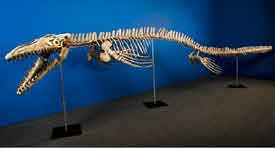|
Giants of the Ancient Oceans
In the Age of Dinosaurs, Marine Reptiles Adapted to Rule the Seas
by Annie Shao, age 16
 Some believe that the fabled dinosaurs dominated Earth until their untimely demise 65 million years ago. But many people do not know that other species may have been even more prominent and had a huge evolutionary significance: the marine reptiles.
Some believe that the fabled dinosaurs dominated Earth until their untimely demise 65 million years ago. But many people do not know that other species may have been even more prominent and had a huge evolutionary significance: the marine reptiles.
In 1764, workers at a limestone quarry in the Netherlands discovered the fossil of a marine reptile. This fossil was thought to be that of a crocodile, a fish or a whale. Much later, the fossil was classified as a completely different animal, a Mosasaurus. According to fossil records, mosasaurs, along with other marine reptiles like ichthyosaurs and plesiosaurs, lived all over the world.
Scientists have concluded that marine reptiles are very similar to the marine mammals and large fish that still live today. The skeleton of an ichthyosaur greatly resembles a dolphin. Marine reptiles shared another important and unusual trait with modern marine mammals; they bore live offspring.
Because many fossilized skeletons of female marine reptiles giving birth have been discovered, scientists accept that marine reptiles had the ability to produce live young. Their young emerged tail first, exactly the same way modern marine mammals give birth. Being born this way keeps the baby from drowning.
The fact that marine reptiles gave live birth to live offspring makes them different from terrestrial reptiles, or land reptiles, who lay eggs. Even lizards, snakes and turtles that live mainly in water must lay their eggs on land. This is because gas exchange through the eggshell happens more efficiently on land than in water.
It appears that the ability to bear live young is a requirement for animals to adapt to a completely aquatic lifestyle. The 60 living species of sea snakes that spend their whole lives in water also produce live young.
This phenomenon raises a significant question for scientists: is there a relationship between the evolution of giving live birth and sex genes? Human gender is determined by genes, reptiles that lay eggs have their gender determined by the environment where the eggs are incubated. For instance, temperature controls whether baby sea turtles and certain lizards are male or female.
This aspect of reproduction makes reptiles different from most animals, who normally have sex chromosomes in their DNA. Because ancient marine reptiles gave live birth, scientists assume they also had sex chromosomes.
Using this new information, a group of scientists from Harvard and the University of Reading in England studied 94 living species of reptiles, birds, and mammals. They found a very strong relationship between sex genes and live births. Scientists then researched the process by which sex was determined in extinct marine reptiles, and found that genes controlling sex are necessary for the evolution of live births.
These sex genes allowed marine reptiles to dominate the seas. The evolution of sex genes led to the ability to have live babies, relieving marine reptiles of the requirement to give birth on land. This freedom allowed marine reptiles to grow larger and develop more efficient fins and tails for swimming. Because of their size and swimming abilities, marine reptiles were the top predators in the ocean food chain of their time.
Although not as famous as their land-dwelling dinosaur cousins, marine reptiles are evolutionarily significant. They were among the first to develop sex chromosomes. And they passed these genes to millions of animals that live today.
[Sources: The New York Times; National Geographic]
|

